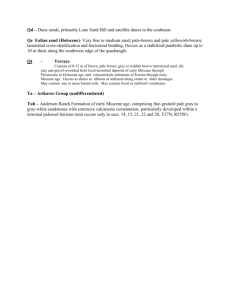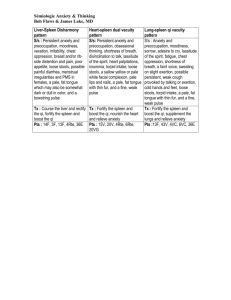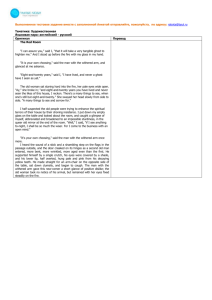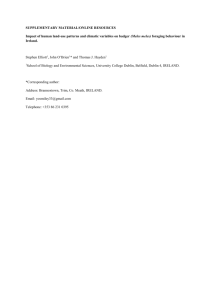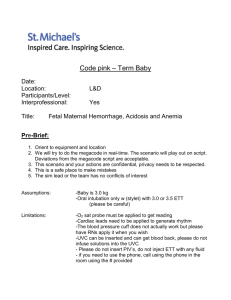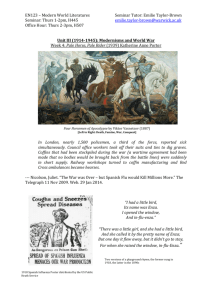Citrullus Dong-Hoon Yang lanatus
advertisement
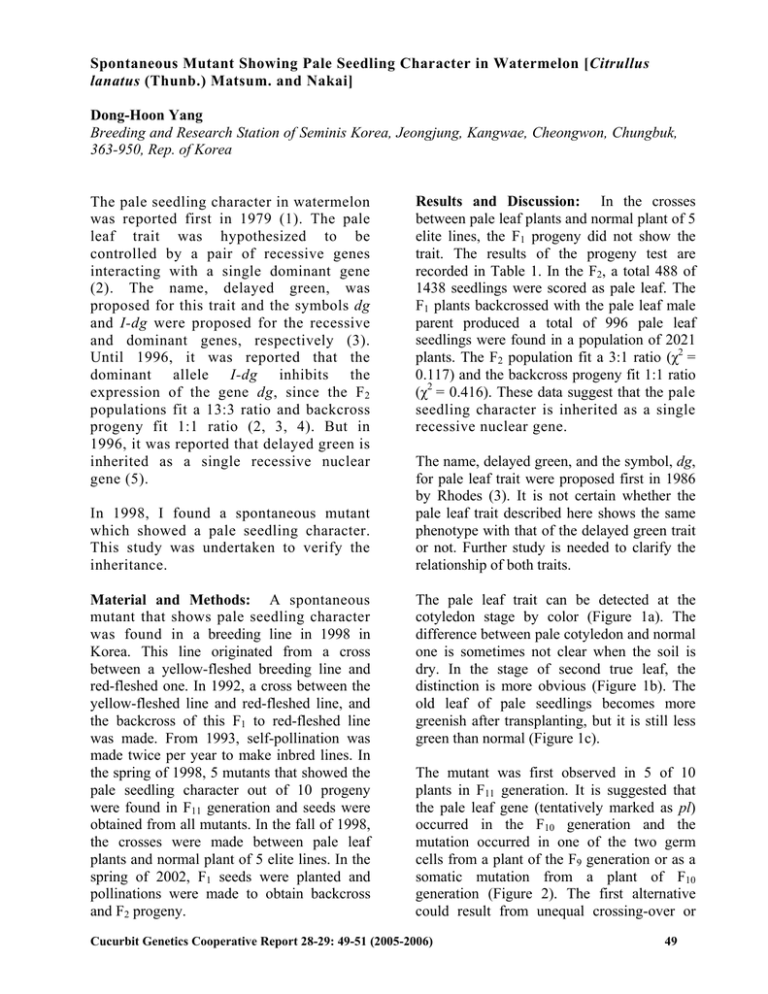
Spontaneous Mutant Showing Pale Seedling Character in Watermelon [Citrullus lanatus (Thunb.) Matsum. and Nakai] Dong-Hoon Yang Breeding and Research Station of Seminis Korea, Jeongjung, Kangwae, Cheongwon, Chungbuk, 363-950, Rep. of Korea The pale seedling character in watermelon was reported first in 1979 (1). The pale leaf trait was hypothesized to be controlled by a pair of recessive genes interacting with a single dominant gene (2). The name, delayed green, was proposed for this trait and the symbols dg and I-dg were proposed for the recessive and dominant genes, respectively (3). Until 1996, it was reported that the dominant allele I-dg inhibits the expression of the gene dg, since the F 2 populations fit a 13:3 ratio and backcross progeny fit 1:1 ratio (2, 3, 4). But in 1996, it was reported that delayed green is inherited as a single recessive nuclear gene (5). In 1998, I found a spontaneous mutant which showed a pale seedling character. This study was undertaken to verify the inheritance. Material and Methods: A spontaneous mutant that shows pale seedling character was found in a breeding line in 1998 in Korea. This line originated from a cross between a yellow-fleshed breeding line and red-fleshed one. In 1992, a cross between the yellow-fleshed line and red-fleshed line, and the backcross of this F1 to red-fleshed line was made. From 1993, self-pollination was made twice per year to make inbred lines. In the spring of 1998, 5 mutants that showed the pale seedling character out of 10 progeny were found in F11 generation and seeds were obtained from all mutants. In the fall of 1998, the crosses were made between pale leaf plants and normal plant of 5 elite lines. In the spring of 2002, F1 seeds were planted and pollinations were made to obtain backcross and F2 progeny. Results and Discussion: In the crosses between pale leaf plants and normal plant of 5 elite lines, the F1 progeny did not show the trait. The results of the progeny test are recorded in Table 1. In the F2, a total 488 of 1438 seedlings were scored as pale leaf. The F1 plants backcrossed with the pale leaf male parent produced a total of 996 pale leaf seedlings were found in a population of 2021 plants. The F2 population fit a 3:1 ratio (χ2 = 0.117) and the backcross progeny fit 1:1 ratio (χ2 = 0.416). These data suggest that the pale seedling character is inherited as a single recessive nuclear gene. The name, delayed green, and the symbol, dg, for pale leaf trait were proposed first in 1986 by Rhodes (3). It is not certain whether the pale leaf trait described here shows the same phenotype with that of the delayed green trait or not. Further study is needed to clarify the relationship of both traits. The pale leaf trait can be detected at the cotyledon stage by color (Figure 1a). The difference between pale cotyledon and normal one is sometimes not clear when the soil is dry. In the stage of second true leaf, the distinction is more obvious (Figure 1b). The old leaf of pale seedlings becomes more greenish after transplanting, but it is still less green than normal (Figure 1c). The mutant was first observed in 5 of 10 plants in F11 generation. It is suggested that the pale leaf gene (tentatively marked as pl) occurred in the F10 generation and the mutation occurred in one of the two germ cells from a plant of the F9 generation or as a somatic mutation from a plant of F10 generation (Figure 2). The first alternative could result from unequal crossing-over or Cucurbit Genetics Cooperative Report 28-29: 49-51 (2005-2006) 49 another type of minute chromatin loss, gain, or qualitative change at meiosis; the second could result from failure of minute chromatin duplication, loss of a minute chromatin fragment, or a qualitative change during meiosis. 3. Rhodes, B.B. 1986. Genes affecting foliage color in watermelon. J. Hered. 77:134-135. 4. Zhang, X.P. and B.B. Rhodes. 1993. Male sterile, ms, in watermelon not linked to delayed green, dg and I-dg. Cucurbit Genetics Coop. Rpt. 16:79. 5. Zhang, X.P., B.B. Rhodes, W.V. Baird, H.T. Skorupska, and W.C. Bridges. 1996. Development of genic male-sterile watermelon lines with delayed-green seedling marker. HortScience Vol. 31, No. 1:123-126 Literature Cited: 1. Rhodes, B.B. 1979. Race 2 anthracnose resistance in a watermelon line with a pale leaf character. Cucurbit Genetics Coop. Rpt. 2:29-30. 2. Rhodes, B.B. 1980. Inheritance of a pale seedling character in Citrullus lanatus. Cucurbit Genetics Coop. Rpt. 3:39-40. Table 1. Segregation for the pale seedling character in the F 2 and backcross populations Generation No. of observed plant Green Pale Expected ratio χ2 Probability F2 Pale x Line A Pale x Line B Pale x Line C Pale x Line D Pale x Line E Total BC (Pale x A) (Pale) (Pale x B) (Pale) (Pale x C) (Pale) (Pale x D) (Pale) (Pale x E) (Pale) Total 50 294 405 264 277 198 1438 102 135 90 95 66 488 3:1 3:1 3:1 3:1 3:1 3:1 0.121 0.000 0.034 0.057 0.000 0.117 0.750>P>0.500 P>0.950 0.900>P>0.750 0.900>P>0.750 P>0.950 0.750>P>0.500 225 290 185 192 133 1025 218 284 179 185 130 996 1:1 1:1 1:1 1:1 1:1 1:1 0.111 0.063 0.099 0.130 0.034 0.416 0.750>P>0.500 0.900>P>0.750 0.900>P>0.750 0.750>P>0.500 0.750>P>0.500 0.750>P>0.500 Cucurbit Genetics Cooperative Report 28-29: 49-51 (2005-2006) <a> <b> <c> Figure 1. Comparison of pale green seedlings with normal one: (left) Top, pale leaf seedling at the cotyledon stage. Bottom, normal, (middle) Top, pale green seedling at the second true leaf stage. Bottom, normal, (right) Left, pale leaf seedling at the pollination stage. Right, normal. Year 1992 1992 1993 Season spring fall spring F1 BC1 F2 1993 fall F3 1994 spring F4 1994 fall F5 1995 spring F6 1996 spring F7 1996 fall F8 1997 spring F9 1997 fall F10 1998 spring F11 Generation Progeny-plant HY477-3 ↙-sibs HY477-3-11 ↙-sibs HY477-3-11-7 ↙-sibs HY477-3-11-7-11 ↙-sibs HY477-3-11-7-11-2 ↙-sibs HY477-3-11-7-11-2-4 ↙-sibs HY477-3-11-7-11-2-4-1 ↙-sibs HY477-3-11-7-11-2-4-1-3 ↙-sibs HY477-3-11-7-11-2-4-1-3-2 ↙-sibs HY477-3-11-7-11-2-4-1-3-2-5 -1 -3 -8 -9 -10 -sibs Putative genotype +/+ +/+ +/+ +/+ +/+ +/+ +/+ +/+ +/+ +/+ +/+ +/+ +/+ +/+ +/+ +/+ +/pl ?/? +/pl pl/pl pl/pl pl/pl pl/pl pl/pl ?/? Figure 2. The suggestive origin for the recessive allele (pl) responsible for the pale seedling character of mutant found in 1998 in Korea Cucurbit Genetics Cooperative Report 28-29: 49-51 (2005-2006) 51

